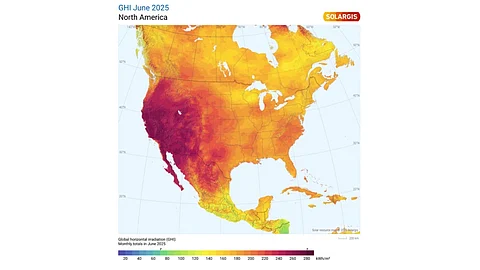

The recent heat dome phenomenon in the US exposed major gaps in solar forecasting, especially under extreme temperatures, according to Solargis
While real-time power prices soared during the heat event, leading to losses, the day-ahead forecasts were not accurate either
Aging solar plants with older inverters are especially vulnerable to heat-related performance drops and price volatility
Solargis stresses the need for precise forecasting tools and long-term weather data as essential for risk management in merchant solar models
The recent heat dome that the US experienced in June 2025 has exposed critical gaps in solar forecasting and asset performance evaluation, particularly under extreme weather conditions. Solar and meteorological data provider Solargis says this highlights the need for advanced data tools to manage weather-related risks and optimize operations, especially for aging and underperforming assets.
For the unversed, a heat dome, a weather phenomenon, traps heat over a certain geographical region in a dome-like formation that does not let the heat escape while suppressing cloud formation. The hot air trapped under it creates intense heat waves that can last several days.
While this condition is injurious to life itself, Solargis sees it also being detrimental to solar energy generation since such high temperatures can lower module output, especially when it comes to older power plants with outdated inverter technology. This has major repercussions for the financial health of solar assets as it leads to a difference in power generation forecasting and real-time prices.
On June 24, 2025, for instance, the heat dome in New York Independent System Operator (NYISO) and Midcontinent Independent System Operator (MISO) saw real-time prices exceed $2,000/MWh while day-ahead prices remained under $500/MWh.
Extreme heat severely affected power grids in the Northeast US, where solar use and electricity demand are rising due to AI-driven data centers. Unlike Texas and California, these regions lack enough battery storage to manage supply-demand gaps. In Texas, strong battery backup helped prevent power emergencies during the heatwave. This, according to the analysts, adds to the reasons to invest in batteries going forward.
“This stark divergence in pricing meant that even minor forecast deviations could result in significant financial losses—particularly where Day-Ahead forecasts overestimated production and also if plants underperformed due to heat-related derating,” explains Solargis CEO for Americas, Giridaran Srinivasan. “Older plants could especially be vulnerable, with operators forced to settle production shortfalls at peak real-time prices.”
This volatile condition is risky for US solar projects that do not have long-term power purchase agreements (PPA), or those that are exiting Capacity Markets, as they are more exposed to real-time price fluctuations.
It is not just the US solar assets at risk with such extreme weather variations, adds Srinivasan, as he brings attention to Europe’s unusually sunny spring this year. Western Europe, for instance, got up to 50% more sunlight than normal, but Southern Europe experienced up to 25% lower irradiance. While this boosts solar energy output, it also shows the need for better forecasting tools for precise data and PV project evaluation to manage solar variability.
As more projects shift to merchant models, precise forecasting is crucial, stresses Slovakia-based Solargis. Long-term weather and price data help anticipate risks better than basic forecasts, supporting both planning and accurate performance analysis after events. Operators then must update system designs and forecasting models to avoid losses during high-temperature, high-revenue periods, stressed Srinivasan.
While Solargis stresses extreme heat as a weather event impacting solar assets, kWh Analytics recently listed hail impact as one of the most severe financial threats to solar power investments, followed by fire (see Hail Costliest Weather Risk For Solar Power Projects).
Meanwhile, non-partisan policy institute Center for American Progress (CAP) blamed the extreme heat waves on ‘fossil-fueled climate change’ that stresses energy systems by increased use of air conditioners, thereby pushing up energy prices. It calls for an expansion of solar and wind energy, along with batteries, to ensure a reliable and efficient energy supply in the country.
At The smarter E/Intersolar Europe 2025 in Munich, Germany, Solargis CEO and Co-Founder Marcel Suri talked about its newest solutions to integrate high-resolution data with physics-based modeling, with TaiyangNews (see Solargis: European Expertise In Solar Data & Simulation).
Speaking of the US, TaiyangNews is co-organizing the 2025 Solar Made in USA summit in collaboration with RE+ and EUPD Research. To be held on September 8, 2025 in Las Vegas, US during the RE+ 2025 event, it will have leading names from the world of solar to discuss the future of US solar and storage manufacturing, and strategies for the players going forward. Registrations are open and can be done here.
